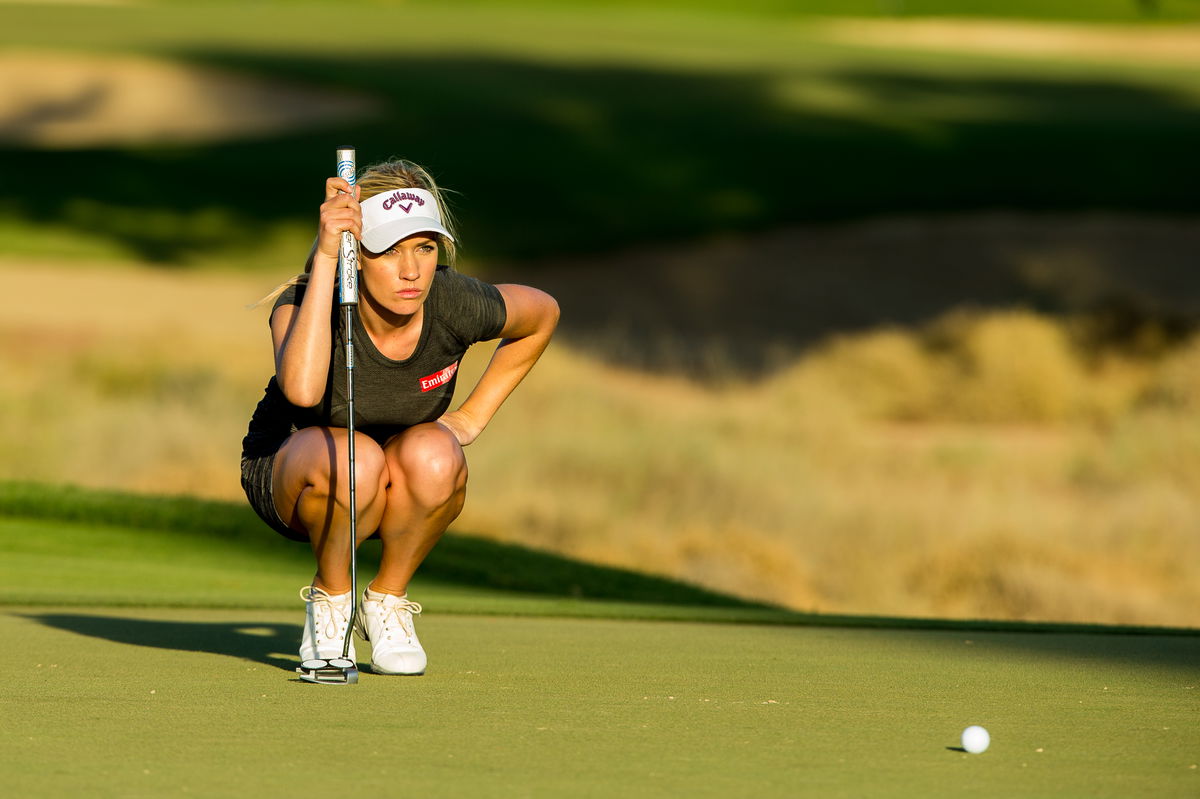
Imago
10/12/2015. Ladies European Tour 2015. Omega Dubai Ladies Masters, Majilis Course, Emirates Golf Club, Dubai, UAE. December 9-12. Paige Spiranac of the USA lines up a putt on the 15th hole during the second round. Credit: Tristan Jones

Imago
10/12/2015. Ladies European Tour 2015. Omega Dubai Ladies Masters, Majilis Course, Emirates Golf Club, Dubai, UAE. December 9-12. Paige Spiranac of the USA lines up a putt on the 15th hole during the second round. Credit: Tristan Jones
Paige Spiranac has never shied away from speaking her mind. “Do what you want to do, wear what you want to wear,” she once told Fox News, giving a firm message of individuality. Known for her polished looks and comfort-first attitude, the former pro turned influencer continues to blend performance with personality, and her recent Instagram post is just another exhibit.
Watch What’s Trending Now!
In a short video, she can be seen playing golf, followed by a clip of a child sipping milk, gagging briefly, then smiling again. She captioned it, “I’ll follow a dress code but doesn’t mean I like it lol,” subtly mocking the strict rules some courses impose. The post quickly went viral, showing once again how Spiranac uses humor to address golf’s most debated traditions.
In another interview previously, she highlighted how many courses still enforce outdated rules, with men expected to wear collared shirts and long pants, while women face even stricter expectations for their tops.
ADVERTISEMENT
Over time, golf’s dress codes have evolved, but tradition still holds its grip. Many private clubs continue to support conservative attire, while public courses are adopting more relaxed rules. This shift reflects a growing effort to make golf more inclusive and appealing to younger audiences. However, the tension between modern comfort and classic etiquette remains visible across global clubs, from the U.S. to Europe.
View this post on Instagram
ADVERTISEMENT
Interestingly, the reason dress codes exist goes beyond aesthetics. They were designed to preserve the game’s heritage, promote respect, and maintain a sense of order on the course. Yet, critics argue these standards often alienate newcomers. Some courses have responded by easing restrictions, while others, like the LIV Golf League, have tightened them. In 2025, LIV announced players can no longer wear shorts in tournaments, enforcing full-length pants all year.
In India, the balance between tradition and change is still unfolding. Clubs like Chandigarh Golf Club and the Karnataka Golf Association uphold formal attire rules, collared shirts, and no jeans remain mandatory. Still, discussions about modernization continue as younger players push for comfort and accessibility. As one Golfshake article in September 2025 noted, many clubs worldwide remain “stuck in the dark ages,” showing that while golf evolves, its dress code debate is far from over.
Once defined by private clubs, strict etiquette, and a narrow demographic, the sport is now rewiring its identity to welcome a broader cast of players. At the grassroots, formats like Topgolf and Drive Shack make golf social and accessible. No membership, no dress code, just fun. They welcome young players who might never step onto traditional fairways. Even LIV’s Bryson DeChambeau and fellow pros recently highlighted golf as “a game that anyone can play,” stressing inclusion at every level. Meanwhile, participation data show a clear change: women now drive a major surge in the game’s growth post-pandemic.
In short, golf is evolving beyond tradition, rethinking exclusivity, gender norms, and access for all players.
Golf redefines tradition and opens its doors to all
Golf is no longer just a game for the few. The R&A reports 39.6 million on-course golfers outside the U.S. and Mexico, up 34% since 2016. When driving ranges and simulators are included, that number climbs to 61.2 million adults. The game is expanding fast and differently.
Women now make up a quarter of golfers in R&A markets and 28% in the U.S., the highest share yet. Diversity is rising, too. Since 2019, the U.S. has added 2.3 million female golfers and 2.1 million golfers of color.
And this change is no accident. Global campaigns like the R&A’s Women in Golf Charter and Make Golf Your Thing push for access and equality. Over 1,300 organizations have pledged to advance inclusion. PGA Tour Commissioner Jay Monahan said, “Our game must continue to evolve and foster a more inclusive environment if it is to better reflect the rest of society.”
Experts agree the effort is overdue. Brandie Deignan, head of equality at Wales Golf, warned, “Unless we reimagine, rethink, and reframe golf, the sport will not flourish.” That urgency now drives reforms in clubs worldwide.
Players are helping redefine the culture. LPGA star Mariah Stackhouse said, “I want the next generation to see more Black players. I don’t want it to be an anomaly.” Stars like Nelly Korda and Lilia Vu credit social media for inspiring new female golfers and breaking old stereotypes. Back in 2023, Paige Spiranac also made headlines for calling out sexism in the sport, demanding fairer representation for women.
Barriers remain, but momentum is strong. Around the world, golf is rewriting its story, evolving beyond tradition to include everyone.
ADVERTISEMENT
ADVERTISEMENT
ADVERTISEMENT
ADVERTISEMENT

